#CU75
Carleton University acknowledges its location on the traditional, unceded territory of the Algonquin nation.

Aerial view of Carleton University, c. 1957. Library Special Collections fonds.
Over the last 75 years, Carleton has made a profound impact on Canadian society. From the early years in the Glebe on First Avenue to its current location on the Rideau River Campus, Carleton has been home to many scholars who have influenced all sectors of Canadian society, from engineering to the arts. Carleton College started with evening classes created to educate soldiers returning from the war. Today, Carleton University offers dozens of programs and degree specializations taught by leading academics. Through the imagination and innovation of Carleton faculty, administrators, alumni, and students, Carleton has had a remarkable 75 years of accomplishment and success. This exhibit will look at some of the faculty and alumni who have made an impact on Canadian society, as well as some of the innovative work done at Carleton over the past several decades.
Education for Veterans
“The University in Khaki might be made the starting point of a great forward movement, not only in agriculture and industry, but in the spiritual, educational, and political life of Canada.” – H.M. Tory, A Khaki University for Canadian Soldiers. The University Magazine, December 1917.
Like other postwar universities, Carleton College was founded on the idea that soldiers returning from the war would need an education. Carleton’s founder, Henry Marshall Tory, addressed this need by collaborating with the Young Men’s Christian Association (YMCA) to provide evening classes and educational materials for soldiers and civil servants interested in furthering their education. The Ottawa Association for the Advancement of Learning and Carleton College began offering courses at the High School of Commerce Building in 1942. By 1948, almost half of the students at Carleton College were veterans and, in 1949, the minister of National Defence established a Canadian Officers’ Training Corps (COTC) at Carleton.
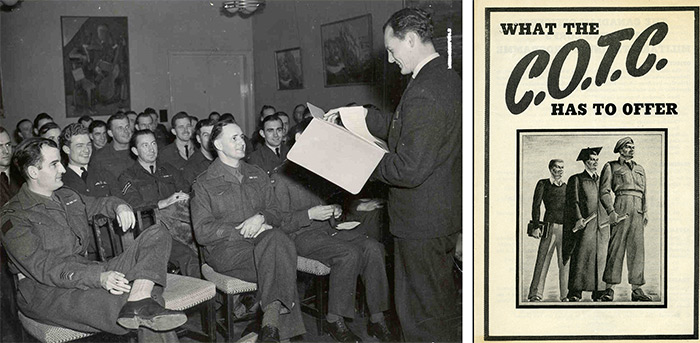
Left: Veterans, many still in uniform, came to Carleton College in the early days, c. 1943. Library Special Collections fonds. | Right: Canadian Officers’ Training Corps information booklet, Canadian Officers’ Training Corps fonds, Archives and Research Collections, Carleton University Library.
The COTC was a military training program that offered students the opportunity to work in the military upon graduation in the Active Force, Reserve Force or Supplementary Reserve for the Canadian military. The first contingent of the COTC was at McGill University in 1912, with contingents successfully operating in the interwar years, and several groups later set up in the 1940s. Depending on the courses taken, the students could work in corps such as the Royal Canadian Artillery, the Royal Canadian Engineers, the Canadian Infantry Corps, the Royal Canadian Army Service Corps, and the Royal Canadian Electrical and Mechanical Engineers Corps.
The first commander of the Carleton College Contingent of the COTC was Major J.W. Mayne, an assistant professor in the Department of Mathematics at Carleton, followed by Major W.H. Kesterton, assistant professor in the School of Journalism. The Carleton College Contingent had its own badge that featured the crossed swords of the Canadian Army and a phoenix similar to the one found in Carleton’s coat of arms. In 1957, the contingent was officially renamed the Carleton University Contingent in accordance with Carleton’s name change, and it continued operations for another 11 years until it officially disbanded on May 31, 1968.
From Carleton College to Carleton University
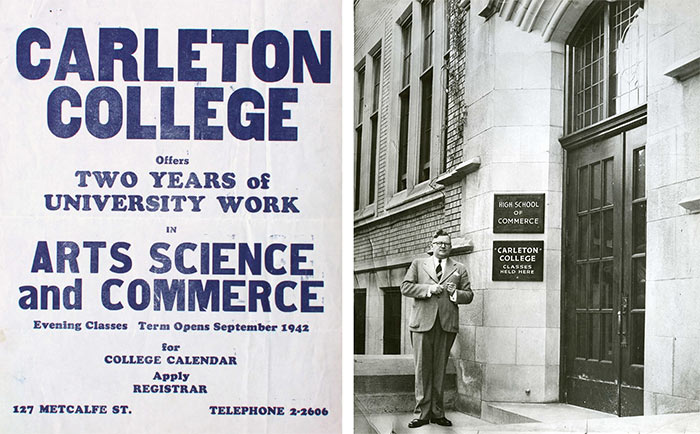
Left: Carleton College Advertisement, 1942. Carleton University Corporate Archives. | Right: Maxwell MacOdrum outside of the High School of Commerce building, c. 1947. Library Special Collections fonds.
The first 15 years of Carleton’s development saw a huge amount of growth. After serving in leadership roles with the YMCA College Grade Education Committee and the Ottawa Association for the Advancement of Learning, H.M. Tory was selected as Carleton’s first president, with Maxwell MacOdrum as his assistant and eventual successor. After establishing itself as the first non-sectarian college in Ottawa, Carleton College began offering full-time day courses taught by a full-time faculty in 1945. The following year, the first six degrees were awarded at Carleton, with three graduates in Journalism and three graduates in Public Administration. In the early 1940s, Carleton College also offered “extension courses” on a wide range of topics that were open to the public and had no prerequisite. Tory taught one of his own called “The Evolution of Knowledge” in 1944. These early years in the development of the school were marked by the transition from courses taught at the High School of Commerce building to the former Ottawa Ladies’ College building at First Avenue in the Glebe.
In April 1952, the Carleton College Act passed with the Ontario provincial government, and Carleton College was given the power to grant university degrees and honorary degrees, giving Carleton full status as a university. That same year, land was acquired from Harry Stevenson Southam in Old Ottawa South, on a site bordered by the Rideau River and the Rideau Canal. The relocation of the university from the Glebe to the Rideau River Campus allowed for an expansion of programs and much-needed space for students. By the time Carleton officially relocated to its current campus in 1959, the Glebe campus was bursting at the seams.

Left: Davidson Dunton on a CBC set c. 1960. Department of University Communications fonds. | Right: President A. Davidson Dunton Portrait, c. 1964. Department of University Communications fonds.
When Carleton University transitioned to the Rideau River Campus, Arnold Davidson Dunton was at the helm of the institution. He managed some of the biggest changes at Carleton during his 14-year tenure as president, spanning from 1958 to 1972. Before Carleton, Dunton was chairman of the Canadian Broadcasting Corporation (CBC) and helped shape Canadian broadcasting as we know it today. In 1963, Dunton was appointed with André Laurendeau to co-chair the Royal Commission on Bilingualism and Biculturalism, which had a major impact on language policy in Canada and led to the creation of the Official Languages Act. Before his positions at Carleton and the CBC, Dunton worked as the editor of the Montreal Standard and as manager of the Wartime Information Board.
While at Carleton, Dunton oversaw a large physical transformation of the campus, as well as a huge increase in enrolment. Over the course of the 1960s, 15 new buildings were constructed on the new campus including administration buildings, laboratories, recreation facilities and a series of residence buildings.
Faculty of Public Affairs
An Institute of Public Administration at Carleton was one of the first proposed academic units, along with the founding of the college itself. The founders of the university were keenly aware of the impact it could have given Ottawa’s location as the centre of government operations. Only six degrees were conferred at Carleton’s first Convocation, all from departments now within the Faculty of Public Affairs. Today, the Faculty of Public Affairs at Carleton encompasses many schools and departments including the Arthur Kroeger College of Public Affairs, the School of Journalism and Communication, the Department of Law and Legal Studies, and the Norman Paterson School of International Affairs (NPSIA) among others.
As an institution in the nation’s capital, Carleton University has had many graduates, faculty and administrators who have worked in public service and political life in Ottawa. The Faculty of Public Affairs has seen many graduates go on to be members of public office in all levels of government, from federal to municipal. Many departments on campus have alumni who are high-ranking government officials, civil servants, politicians and ambassadors.
The Norman Paterson School of International Affairs was one of the first graduate schools for international affairs in Canada. Named after the late Canadian senator Norman Paterson, the school was first developed in 1965 to train students in international affairs and policy in Canada. Like many programs at Carleton, NPSIA benefits greatly from its proximity to Parliament Hill and the many connections that it has throughout the public service. The faculty currently has many graduates working in leadership roles in politics, including:
- Niki Ashton, MP for Churchill—Keewatinook Aski, Manitoba and candidate for the federal New Democratic Party leadership
- Yasir Naqvi, Ontario MPP for Ottawa Centre and Attorney General of Ontario, and
- Jim Watson, Mayor of the City of Ottawa and former Ontario MPP for Ottawa West-Nepean.
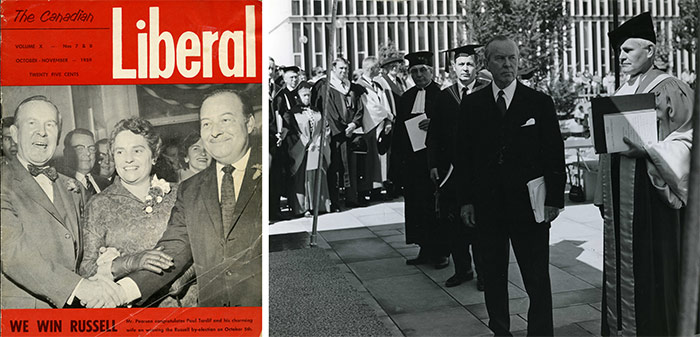
Left: The Canadian Liberal, Volume X, 1959. Geoffrey Pearson fonds, Archives and Research Collections, Carleton University Library. | Right: Lester B. Pearson at Convocation, 1967. Department of University Communications fonds.
Carleton’s connection to politics is not just with graduates of the university. Many former faculty members and university chancellors have also held important positions in government. In 1969, Carleton welcomed its third chancellor, Lester B. Pearson. Pearson served as chancellor of Carleton from 1969 to 1972 while also occasionally lecturing in history and politics. Before his time at Carleton, Pearson had served in the military, held positions with the United Nations and was a Member of Parliament. Most notably, Pearson served as the 14th prime minister of Canada and was the first Canadian to win the Nobel Peace Prize. Pearson was awarded the Prize in 1957 for his role with the UN in seeking a resolution to the Suez Crisis.
Other former chancellors have included:
- Herb Gray, former MPand former deputy prime minister from 1997 to 2002
- Arthur Kroeger, longtime public servant and deputy minister for five different federal departments
- Gordon Robertson, former Clerk of the Privy Council and Secretary to the Cabinet
- Ray Hnatyshyn, former Governor General of Canada, and
- Marc Garneau, former president of the Canadian Space Agency and current Transport Minister.
The School of Journalism and Communication
Also located in the Faculty of Public Affairs is the School of Journalism and Communication, the first journalism school in the country. Lead originally by Wilfrid Eggleston, the journalism program at Carleton began in 1945, with three of the first Bachelor of Journalism degrees awarded to women in 1946. Since the School of Journalism was founded, graduates have gone on to make a massive impact on Canadian journalism and graduates of the school can be found in newsrooms across the country. Carleton journalism graduates have reported on some of the world’s biggest stories over the past several decades, from international affairs and political scandals to major stories in economics, public health and natural disasters.
Within the department itself, faculty and students of the School of Journalism have produced many publications over the years that were circulated amongst the department, the university and the community at large. Today, Carleton Journalism students actively participate in the production of Centretown News, a community newspaper serving the Ottawa neighbourhood of the same name.
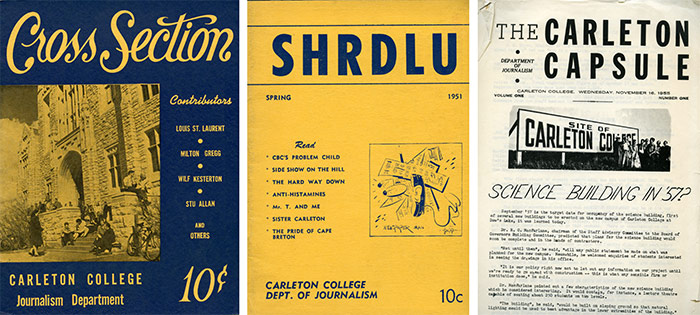
Left: Cross Section, Department of Journalism publication, 1951. Archives and Research Collections, Carleton University Library. | Middle: SHRUDU, Department of Journalism publication, 1951. Archives and Research Collections, Carleton University Library. | Right: The Carleton Capsule, Department of Journalism publication, 1955. Archives and Research Collections, Carleton University Library.
Having attended one of the top journalism schools in the country, Carleton School of Journalism graduates are found on leading television and radio programs and on the mastheads of Canada’s newspapers nationwide. Some of the most recognizable graduates include:
- Peter Worthington, founding editor of the Toronto Sun, and member of the Canadian News Hall of Fame
- Rosemary Barton, Host of Power & Politics on CBC
- James Duthie, Sportscaster on TSN
- Marc Mackinnon, Senior Foreign Correspondent for The Globe and Mail
- Nahlah Ayed, Foreign Correspondent with the CBC
- Michel Cormier, Bureau Chief for CBC News in Montreal
- Ed Greenspon, Editor-at-Large, Bloomberg News in Canada, and former Editor-in-Chief of The Globe and Mail
Faculty of Arts and Social Sciences
“The trained intelligence of a nation is its greatest asset, greater than any material resource.” – H.M. Tory
The Faculty of Arts and Science was one of the first faculties developed at Carleton, officially organized in 1945 along with full-time day classes at the college. Reorganized as the Faculty of Arts and Social Sciences in 1997, the faculty encompasses over 30 departments and offers programs in art history, English, French, Psychology, Sociology and Anthropology, Linguistics and Language Studies, History, the Humanities, Philosophy and Cognitive Science, among others.
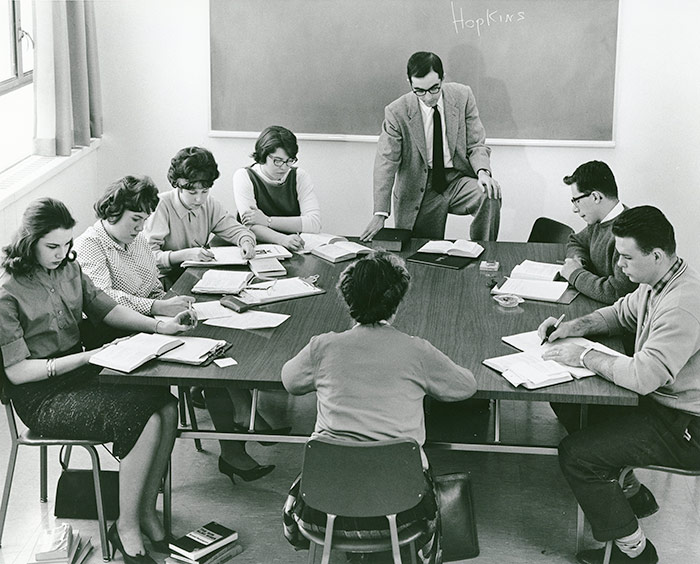
Professor B. Jones discusses 20th century poetry with his class, c. 1958.
Many graduates from the Faculty of Arts and Social Sciences have gone on to work in leading roles in Canadian museums, art galleries, cultural institutions and in government positions. The Faculty of Arts and Social Sciences at Carleton is also home to three Canada Research Chairs: Stephan Gruber, the Canada Research Chair in Climate Change Impacts/Adaptation in Northern Canada; Stuart J. Murray, Canada Research Chair in Rhetoric and Ethics and Ruth Phillips, Canada Research Chair in Modern Culture.
Just a few of the notable graduates from the Faculty of Arts and Social Sciences include:
- Clayton Beattie, former Brigadier-General and Operations Officer and Canadian Contingent Commander for the United Nations
- Lorna de Blicquy, first Canadian to be inducted into the International Women in Aviation Pioneer Hall of Fame, and Officer of the Order of Canada
- Robert Carmichael, artist responsible for the design on the Canadian loonie
- Julie Nesrallah, opera singer
Originally founded in 1957 as the Institute of Canadian Studies, the School of Indigenous and Canadian Studies is celebrating its 60th anniversary this year. The institute was established to “foster and stimulate Canadian Studies of an inter-disciplinary nature, with primary emphasis on cultural history,” and was initially comprised of three co-operative departments including English, French and History. Eventually, the institute became an independent academic unit and offered its own degree program. Many Carleton administrators and leading academics spent time in leadership roles in the Institute of Canadian Studies including Davidson Dunton, former president of the university, and Pauline Jewett, former chancellor. Other notable former faculty members include Robert MacDougall, former director of the Institute of Canadian Studies and professor of English Language and Literature, and Sydney Wise, professor in History and Canadian Studies and Canadian military historian.
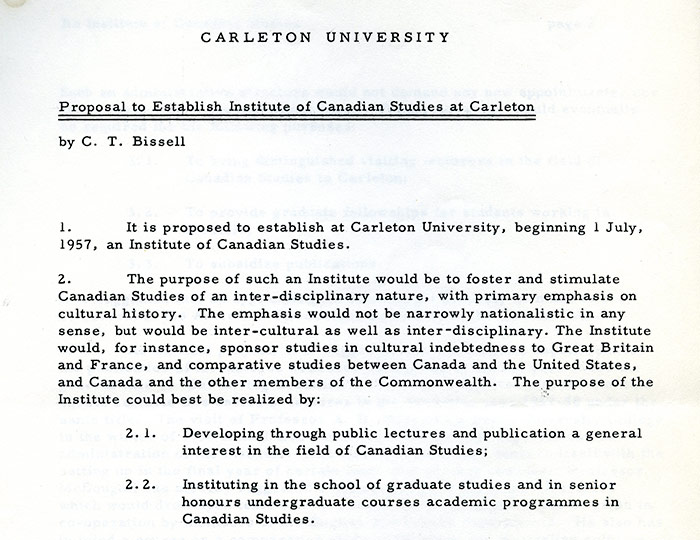
Excerpt of “Proposal to Establish Institute of Canadian Studies at Carleton,” C.T. Bissell, 1957.
School of Canadian Studies fonds, Carleton University Corporate Archives.
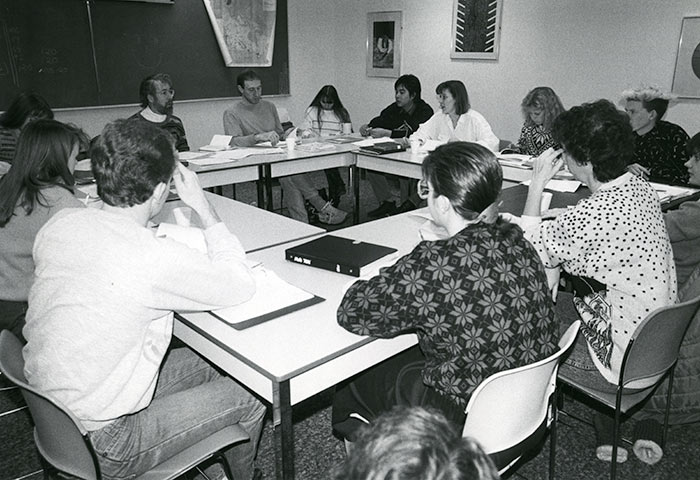
Canadian Studies seminar class, 1988. Library Special Collections fonds.
In 2016, the Board of Governors approved a name change to the School of Indigenous and Canadian Studies in order to reflect the current research focuses of the department and to acknowledge the critical importance of Indigenous studies to the study of Canada in general. The department began to offer an Indigenous Studies stream in 2010 and, in 2017, the department will offer a Combined Honours Degree in Indigenous Studies.
In addition, the department offers a graduate program in Heritage Conservation, first developed by Julian Smith, an architect and conservator known internationally for his work in heritage conservation and cultural landscape theory. Smith was named a Member of the Order of Canada in 2016.
In 1992, the Carleton Aboriginal Education and Research Centre (CAERC) was formed at Carleton. The goal of the centre was to expand accessibility of post-secondary education to Indigenous peoples both at Carleton and in the surrounding areas, with assistance and direction from the local Indigenous community. The first director of CAERC was Madeline Dion-Stout, who was the first Indigenous person to graduate from the Norman Paterson School of International Affairs. Dion-Stout was made a member of the Order of Canada in 2015, “for contributing to the development of Aboriginal health care in Canada as a nurse, researcher and advocate.” In 2003, CAERC reorganized into the Centre for Indigenous Research, Culture, Language and Education (CIRCLE) and currently “strives to facilitate the research and delivery of linguistic and cultural materials of the First Peoples of North America as well as all Canadians.”

Madeliene Dion Stout, first director of the Carleton Aboriginal Education and Research Centre, May 1993. Development and Alumni Services fonds.
In 2013, the student centre Ojigkwanong opened in Paterson Hall. The centre provides a space for Indigenous students to gather and hosts events and lectures for students throughout the year. In recent years, Carleton has started to offer programs and specializations in Indigenous studies, with the School of Indigenous and Canadian Studies offering the first fully Indigenous undergraduate program beginning in the fall of 2017. The development of Ojigkwanog and the recent developments made to Indigenous education on campus is in line with Carleton’s Aboriginal Coordinated Strategy, which was approved by the Carleton University Senate in 2011. The goal of the strategy is to recognize Indigenous culture and worldviews on campus, and increase indigenous teaching and research.
In 1987, the Institute of Women’s Studies was formed at Carleton. The institute brought together academics working on women’s issues, including equality, social policy, sexuality and the history of women. The institute was later renamed the Pauline Jewett Institute of Women and Gender Studies after former chancellor Pauline Jewett. She first lectured at Carleton in 1955 in political science, and later became director of the Institute of Canadian Studies from 1971 to 1974. In 1963, she was elected MP for Northumberland, Ont., and in 1979 as the Member of Parliament for New Westminster-Coquitlam, B.C. In 1991, Jewett was made an Officer of the Order of Canada and, in 1992, she was appointed to the Privy Council. In addition to her many accomplishments as an academic and scholar, Jewett was the first woman to lead a Canadian university, with her appointment as president of Simon Fraser University in 1974.

Left: Women’s Studies pamphlet, 1988-89. Department of University Communications fonds. | Middle: Former chancellor and professor Pauline Jewett, 1974. Library Special Collections fonds. | Right: Joint Chair of Women’s Studies at Carleton University and the University of Ottawa, Monique Begin, 1987. Development and Alumni Services fonds.
In 1985, a Joint Chair in Women’s and Gender Studies was established in co-operation with the University of Ottawa, and the first incumbent was the Honorable Monique Bégin. In 1967, Bégin was secretary of the Royal Commission on the Status of Women in Canada, which reported on the status of women in the country and offered recommendations to ensure equal opportunities for women. Since then, there have been 12 chairs who have advocated for women on campus and acted as a resource for students and faculty pursuing research in women’s and gender studies at both universities.
The Carleton Library Series
In 1963, Robert MacDougall, a professor in the Department of English Language and Literature, established the Carleton Library Series (CLS) with colleagues to publish and disseminate documents relevant to Canadian history. The series published books in many disciplines, from economics to social science and history. The first work published by the CLS was Lord Durham’s Report, followed by selections from The Confederation Debates in the Province of Canada. Initially published by McClelland & Stewart, the CLS filled a gap in Canadian non-fiction work and allowed students to access material that was previously not easily available.
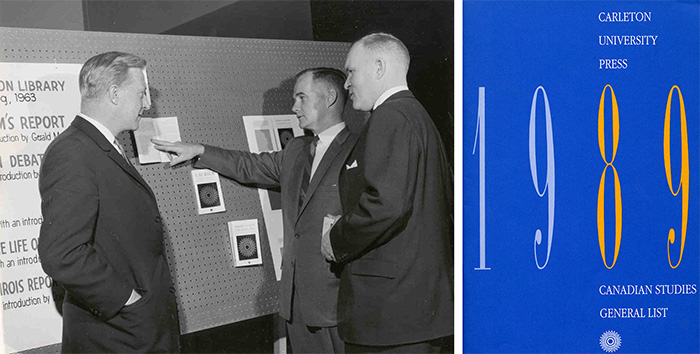
Left: Jack McClelland, Dr. R. L. MacDougall, Jim Tatton. The Carleton Library Series, May 26, 1963. Library Special Collections fonds. | Right: Canadian Studies General List, Carleton University Press, 1989. Department of University Communications fonds.
From 1981 to 1999, the CLS was published by Carleton University Press, created with the intention of supporting the CLS. As noted by Michael Gnarowski, general editor from 1972 to 1993, teaching courses in Canadian Studies would have been difficult without the existence of the CLS and for a time it was considered one of the most important scholarly projects taken on by Carleton University.
Today, the CLS continues to be published by McGill-Queens University Press, and is directed by an editorial board of scholars from many different departments at Carleton. The Carleton Library Series has published over 200 titles and continues its mission of providing access to Canadian material, strengthened by the digitization of many books in the series and even further expanding its reach.
Faculty of Science
“The university is, in fact, virtually the only place where science can be pursued for its own sake.” – E.W.R. Steacie
Science courses at Carleton began with evening classes in Physics, Mathematics, Biology, Geology, and Chemistry when Carleton College was founded in 1942. In 1963, the Faculty of Science at Carleton became distinct from the Faculty of Arts and Science, and the faculty has since grown to include additional programs in Health Science, Earth Science, Environmental Science, Biochemistry and Neuroscience.

Photo of H.H.J. Nesbitt, associate professor of Biology, Carleton College, 1958. Department of University Communications fonds.
One of the earliest professors in the Faculty of Science was Herbert John Nesbitt, who joined Carleton as a full-time faculty member in 1948. Before joining Carleton, Nesbitt worked at the federal Department of Agriculture. The H.H.J Nesbitt Biology Building was named after him, as he played a large role in developing science education at Carleton and making the Biology program at Carleton what it is today. The Department of Biology at Carleton is home to three Canada Research Chairs, including Steven Cooke, Canada Research Chair in Fish Ecology and Conservation Physiology; Mark Forbes, Canada Research Chair in Ecological Parasitology/Wildlife Conservation; and Ken Storey, Canada Research Chair in Molecular Physiology. The department has one of the top greenhouses in the country.
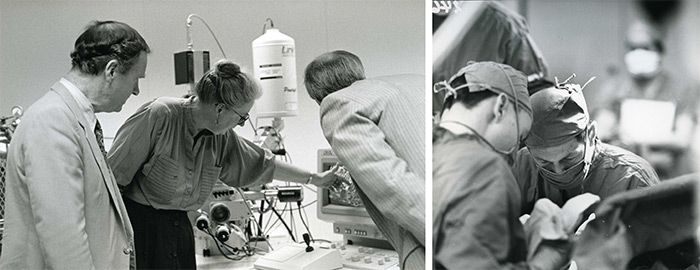
Left: Dr. Farquhar, Dr. Margaret McCully, and Nigel Lloyd (NSERC) with new electron scanning microscope, 1991. Department of University Communications fonds. | Right: Dr. Wilbert J. Keon in an operating room, c. 1990. Development and Alumni Services fonds.
In 1966, Dr. Margaret McCully joined the faculty. A leading plant biologist, McCully published hundreds of academic articles and is considered one of the leading scholars in electron microscopy. McCully taught students at Carleton for more than 30 years, contributing significantly to the education of leading scientists in various disciplines.
In 1957, Wilbert J. Keon graduated from Carleton’s St. Patrick’s College with a Bachelor of Science degree after completing his dissertation, “The Salk Vaccine: Its Development and Significance,” before attending medical school at the University of Ottawa. Keon is known as the first Canadian to perform an artificial heart transplant and was responsible for the development of the Ottawa Heart Institute. In 1994, Keon returned to Carleton to accept an honorary degree from his alma mater. In addition to his distinguished career in medicine, Keon was a member of the Senate of Canada from 1990 to 2010.
Carleton awarded the first master’s degree in Science on June 2, 1958, to Ivan Fellegi, a student in the Department of Mathematics and Statistics who completed his courses in the evening while working during the day at Statistics Canada (then the Dominion Bureau of Statistics). Fellegi would also be the first person awarded a PhD in Science at Carleton University in 1961. After his time at Carleton, Fellegi continually advanced his career within Statistics Canada, eventually becoming the second-longest serving chief statistician from 1985 to 2008. Another notable graduate of the mathematics department at Carleton is John Manley, former deputy prime minister under Jean Chrétien from 2002 to 2003, and current CEO of the Business Council of Canada.
The Department of Physics at Carleton has seen a number of esteemed scholars swing through the doors of the Herzberg Building. Carleton’s connection to the field of Physics goes back to the school’s founder, Henry Marshall Tory, who was himself a physicist and at one time was president of the National Research Council (NRC), Canada’s national organization for research in science and technology.
Ten years later, the NRC also saw C.J. Mackenzie, Carleton’s second chancellor, as its president in 1939. These connections to two of Carleton’s formative administrators would have an impact on Carleton’s research in science and technology over the years to come. In 1948, Gerhard Herzberg arrived at the NRC to assist in a leadership role within the division of physics, and later came to Carleton as a visiting professor in Physics and Chemistry. Eventually, Herzberg would become chancellor at Carleton University, and the physics building was named in his honour. Herzberg won the Nobel Prize in Chemistry in 1971 for “his contributions to the knowledge of electronic structure and geometry of molecules, particularly free radicals.” Herzberg is widely acknowledged as one of Canada’s greatest physicists.
The Department of Physics at Carleton and the NRC are also intimately tied because of the move of the NRC’s high-energy physics research division to Carleton in the mid-1970s. This move led to the creation of the Centre for Research in Particle Physics, which resulted in many successful research projects and collaborations with other leading organizations in North America, including a major collaboration with CERN (European Laboratory of Particle Physics). In 1969, Peter Grünberg joined Carleton as a postdoctoral fellow in the Department of Physics and spent three years doing research at the university. In 2007, he was jointly awarded a Nobel Prize in Chemistry “for the discovery of Giant Magnetoresistance” along with Albert Fert. The two academics made the discovery independently of each other in 1988, and shared the Nobel Prize for this groundbreaking work.
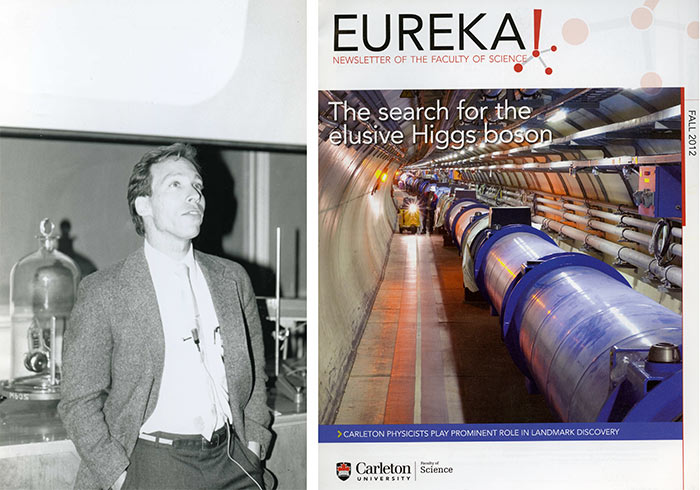
Left: Lawrence Krauss, 1989. Development and Alumni Services fonds. | Right: “The search for the elusive Higgs boson,” Cover of Eureka! Newsletter of the Faculty of Science, Fall 2012. Archives and Research Collections, Carleton University Library.
Another alumnus from the Department of Physics was Lawrence Krauss, who graduated from Carleton with undergraduate degrees in Mathematics and Physics in 1977. He went on to graduate school at the Massachusetts Institute of Technology and taught at Yale before landing his current position as Foundation Professor in the School of Earth and Space Exploration at the Department of Physics at Arizona State University. Krauss is a leading theoretical physicist and is a well-known figure in his field, having won the 2012 United States National Science Board Public service medal for his commitment to public education in Science.
In 2013, Carleton students and researchers were recognized for their contributions to the discovery of the Higgs-Boson particle by François Englert and Peter W. Higgs. The citation for the award read: “For the theoretical discovery of a mechanism that contributes to our understanding of the origin of mass of subatomic particles, and which recently was confirmed through the discovery of the predicted fundamental particle, by the ATLAS and CMS experiments at CERN’s Large Hadron Collider.” Carleton faculty, research assistants and graduates from the Department of Physics contributed greatly to this discovery.
The Faculty of Engineering and Design
“Our future success is our own energy, ability and imagination.” – William Edwin Beckel
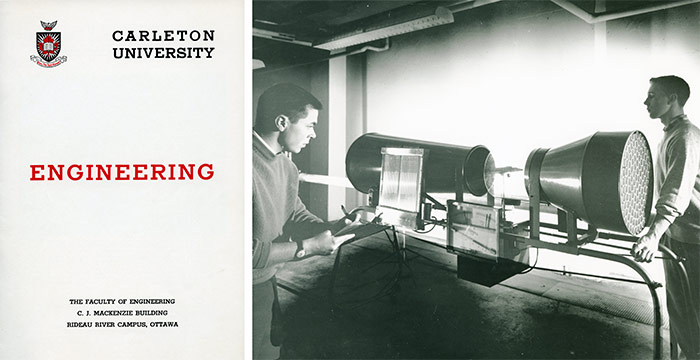
Left: Carleton University Engineering brochure, Department of University Communications fonds. | Right: Final-year engineering students demonstrate the use of the Wind Tunnel for detecting flutter in aircraft wings and tail assemblies, c. 1958. Library Special Collections fonds.
The Faculty of Engineering and Design at Carleton has been a hub of innovation. Situated in Ottawa, one of the technology centres in Canada, the engineering departments at Carleton provide students with access to state-of-the-art research labs, and award-winning faculty who include leading innovators in engineering and design.
Though Engineering classes at Carleton started in the mid-1940s, the School of Engineering at Carleton University was first established as an academic unit in 1957, and as a separate faculty in 1963. As noted in the book Creating Carleton: The Shaping of a University by Blair Neatby and Don McEwon, the Engineering Department at Carleton was boosted by the support and direction of former Chancellor Chalmers Jack Mackenzie, a Canadian civil engineer who contributed greatly to the development of engineering education in Canada. Mackenzie served as chancellor of Carleton from 1954 to 1968, and also served as president of leading organizations such as the NRC, Atomic Energy of Canada Ltd., and the Atomic Energy Control Board.
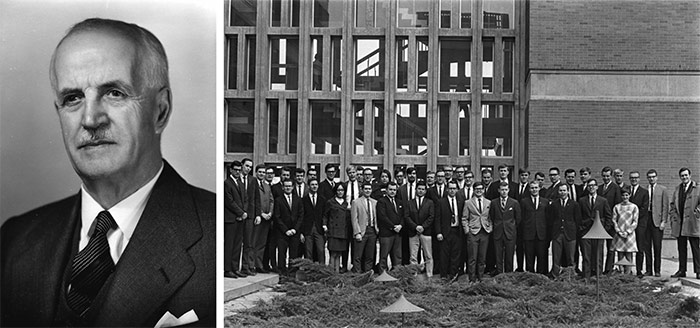
Left: Chancellor Chalmers Jack Mackenzie, c. 1953. Department of University Communications fonds. | Right: Civil engineering class of 1968 group photo outside the C.J. Mackenzie Building. Department of Mechanical and Aerospace Engineering fonds, Archives and Research Collections, Carleton University Library.
During his time at Carleton, Mackenzie encouraged a broad approach to Engineering education, which allowed students to obtain a more comprehensive education before entering a field of specialization, which was contrary to the typical organization of specialized programs at the time. Today, Carleton offers several programs, including civil, environmental, mechanical and aerospace, and systems and computer engineering. The faculty is also home to programs in Architecture and Urbanism and Industrial Design. In 1965, Engineering courses moved from the Tory building to the newly built C.J. Mackenzie Building for Engineering.
In 1988, Carleton introduced the first aerospace engineering program in Canada. The Department of Mechanical and Aerospace Engineering (formerly the Department of Mechanical and Aeronautical Engineering) offers students an opportunity to work on innovative projects as a part of their coursework. In 2002, Engineering students began working on the Carleton University Simulator Project, a unique flight simulator that allows free rotation in any direction and simulates an airplane spin. With projects such as these, Carleton’s Faculty of Engineering offers students the opportunity to engage with innovative research, allowing them to take that valuable experience with them into the workforce.
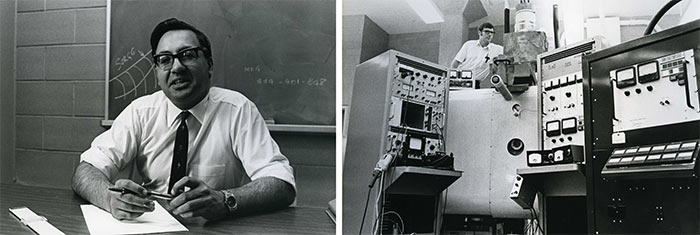
Left: H.I.H. Saravanamuttoo – Associate Professor of Engineering, 1974. Department of University Communications fonds. | Right: Professor John Goldak with Electron Beam System, used to develop industrial processes such as welding and melting, c. 1975.
Carleton is one of the only universities that’s home to a fully functional gas turbine engine, located in the H.I.H. Saravanamuttoo Gas Turbine Laboratory, named after esteemed researcher and Carleton professor, Herbert Saravanamuttoo. In 1951, Saravanamuttoo wrote Gas Turbine Theory, a textbook that is one of the most accepted texts in this field, with its most recent editions now co-authored by Carleton Professor Paul Straznicky. In 1970, Saravanamuttoo joined Carleton’s faculty and has led graduate students on a number of projects in collaboration with the National Research Council.
Carleton leads in several research areas, including advanced propulsion systems, rotorcraft, space robotics, and advanced aerodynamics.
The Department of Systems and Computer Engineering at Carleton conducts research in areas such as biomedical engineering, communication and computer systems, software engineering, interactive media systems and analysis techniques. The department has more than a dozen laboratories and has four Canada Research Chairs among its distinguished faculty.
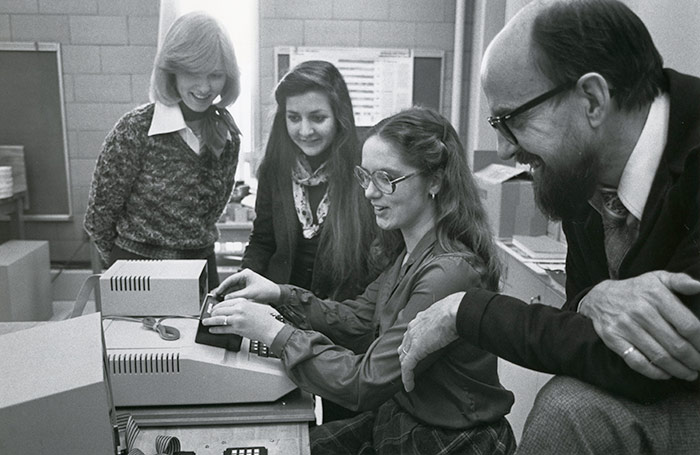
Computer Systems Engineering, 1982. Library Special Collections fonds.
In 1997, Prof. Monique Frize joined the Department of Systems and Computer Engineering at Carleton. After many years of working as a clinical engineer, Frize turned her career toward teaching and research in an academic environment. In 1992, Frize was made an Officer of the Order of Canada for her contributions in the field of biomedical engineering and for her dedication to the advancement of women in Science and Technology. She was one of the first NSERC Chairs for Women in Engineering, a title that she held from 1997 to 2004, and is highly regarded as one of the early leaders of women in engineering.
Other notable graduates from the Department of Systems and Computer Engineering include Charles Chi, Carleton chancellor since 2011 and former partner at Greylock Partners (one of the first venture capital firms in the United States) and Shona Brown, former vice-president of Business Operations at Google and recipient of the A.D. Dunton Alumni Award of Distinction.
The Department of Civil and Environmental Engineering at Carleton trains engineers in engineering for our built environment and offers courses in diverse areas, including infrastructure, architectural conservation and sustainability, and wastewater management. In 2001, Carleton and NSERC introduced an Industrial Research Chair in Fire Safety Engineering, a position held since then by George Hadjisophocleous. The research done by the chair, faculty and students in the department responds to a growing need for research on fire safety, with experiments providing insight on small-and large-scale fires. The Department of Civil and Environmental Engineering is home to the first program that offers courses for fire safety engineering in Canada.
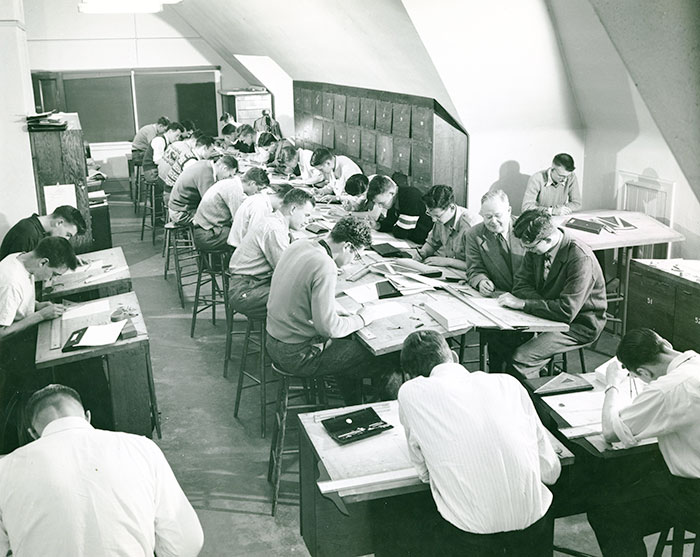
Students in drafting class, c. 1962. Library Special Collections fonds.
The Azrieli School of Architecture and Urbanism was first founded in 1968 as the School of Architecture with Douglas Shadbolt at the helm. Graduates from the school have gone on to join architecture firms across the country and have made a significant impact on our built environment. Graduates from Carleton’s School of Architecture include Gregory Henriquez, who in 2004 won the Governor General’s award in architecture for his work on the Lore Krill Housing Co-operative in Vancouver, and Yves Gosselin, who served as chief architect and director of design and construction at the National Capital Commission, the Crown Corporation responsible for federal lands in the capital.
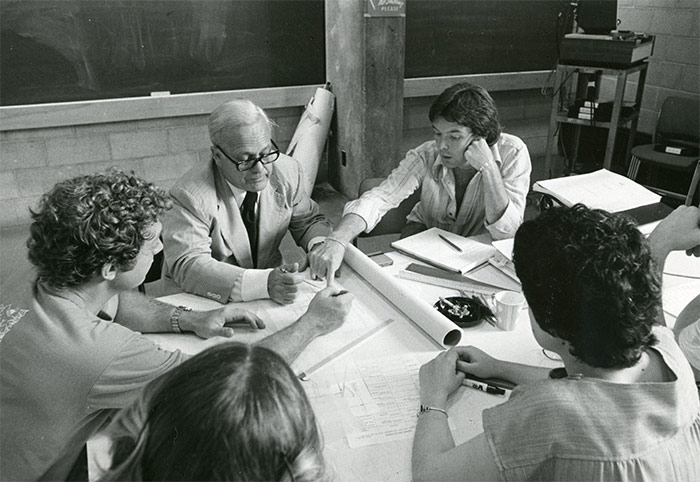
“Store front architecture” students and an instructor engage in conversation, summer 1977. Library Special Collections fonds.
Carleton’s School of Architecture has conducted leading research projects with faculty and graduate students in several laboratories, including the Carleton Immersive Media Studio (CIMS), home to projects that use digital technology to assist with architectural conservation and visualization. In 2014, Canadian Architect magazine acknowledged Carleton’s unique research in this area under the leadership of director Stephen Fai. Recent projects from the Carleton Immersive Media Studio have included a virtual tour of the Senate of Canada and Building Information Models (BIMS) of the Parliament Buildings. The School of Architecture and Urbanism is also home to the Carleton Solids and Tectonics Laboratory, which focuses on the study of materiality in architecture, and the Urban Research Lab.
Industrial Design
The School of Industrial Design was established at Carleton in 1973. Students from this department are leading innovators shaping the way that we think about design and the environment around us. One of the most successful graduates from the school is Karim Rashid, who received his degree in 1982. After graduation, Rashid and two fellow Carleton Bachelor of Architecture alum started a clothing line in Toronto named “Babel.” After pursuing further studies in Italy, Rashid developed several products for which he is well known, such as the “Garbo” waste bin, and the “Oh Chair” designed for Umbra. Currently, Rashid owns a design firm in New York. He is a recipient of the Industrial Designers Society of America Industrial Design Excellence Award.
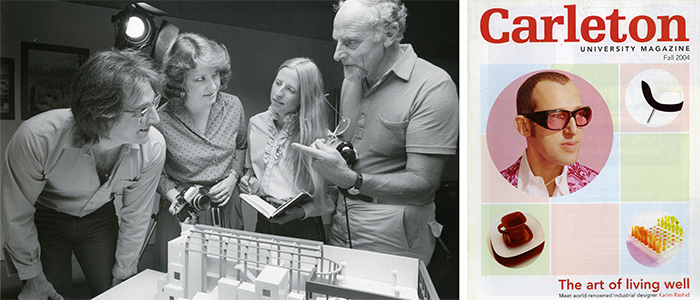
Left: Architecture and Industrial Design class, c. 1979. Library Special Collections fonds. | Right: Cover, “The art of living well,” profile article on Karim Rashid, Carleton University Magazine, Fall 2004.
Sprott School of Business
In 1949, the first Commerce degree was awarded at Carleton College. Since then, Carleton developed its own School of Business, with leading programs in Commerce, International Business, Accounting, and Information Systems. In 2006, the school was granted faculty status. Today, it is home to research centres such as the Sprott Centre for Social Enterprises, the Centre for Information Technology, Organizations and People, and the Centre for Research and Education on Women and Work.

Left: Professor Kiggundu conducts lecture, School of Business, 1985. Library Special Collections fonds. | Right: A faculty member and student from the School of Business study, 1985. Library Special Collections fonds.
In 2001, the school was renamed to the Sprott School of Business after Eric Sprott, a Carleton alumnus and major donor. After graduating with a Bachelor of Commerce in 1965, Sprott went to Toronto where he worked in major banking and investment firms such as Merrill Lynch and Loewen Ondaatje McCutcheon before heading his own securities firm, Sprott Securities.
Sprott’s donation to Carleton supported students through bursaries and has allowed the Sprott School of Business to flourish. Over 10,000 students have graduated from programs in the school and have gone on to have successful careers in many industries. In 1992, the Management Development Program for Women was launched, the first of its kind in Ontario. In the past 25 years, hundreds of women have graduated from the program and it is considered one of the most successful professional development programs offered.
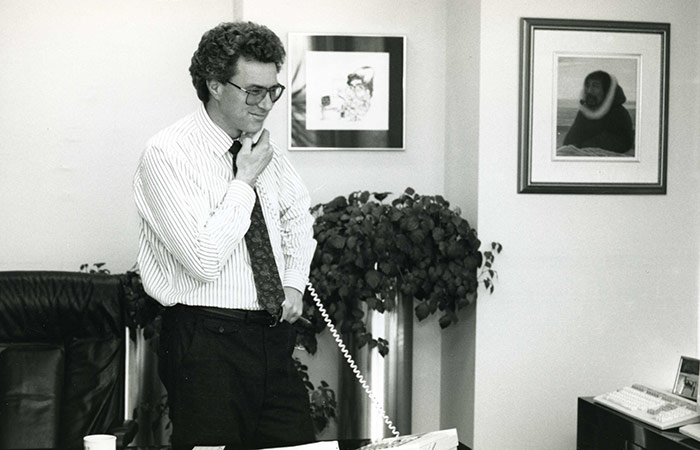
Eric Sprott, 1990. Development and Alumni Services fonds.
Another notable graduate with a Bachelor of Commerce degree is Janice Charette, who graduated from Carleton in 1984. She is currently the Canadian High Commissioner to the United Kingdom and was previously Clerk of the Privy Council – the second woman who has held that position.
Community Connections
Carleton University has had a strong connection to Ottawa and surrounding communities since its development began with the Ottawa Association for the Advancement of Learning. Carleton has occupied space in Centretown, the Glebe and Ottawa South, and reaches the broader community through fundraising activities, outreach and partnerships.

Left: Carla Parchelo, music announcer for CKCU radio station, November 1991. Department of University Communications fonds. | Right: President William E. Beckel presents a cheque to the United Way Kick-off, September 29, 1989. Department of University Communications fonds.
Since the 1950s, Carleton has engaged in philanthropic efforts throughout the city, most notably with its annual United Way campaign. In the 1950s, a Carleton student group formed a chapter of the Red Feather Society, an organization that helped raise money for the United Way. Today, Carleton still raises funds for United Way Ottawa, through many campus activities.
In 1975, Radio Carleton secured an FM licence for radio station CKCU-FM, becoming the first campus radio station on the FM dial. Over the years, its diverse programming has become a staple in the Ottawa radio community, its reach extending far beyond campus.
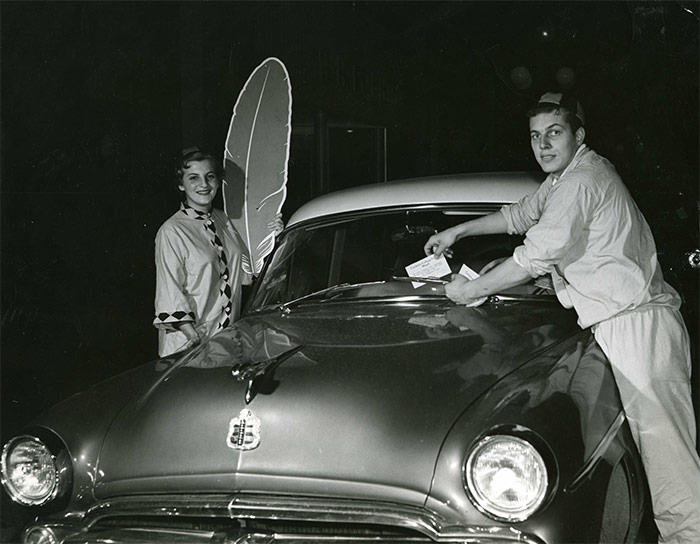
Red Feather Club members Jacqueline Aronson and John Redfern place flyers on cars for the Red Feather Campaign during Frosh Week, 1954. Library Special Collections fonds.
Carleton University also developed Instructional Television (ITV) to provide more access to lectures for students and for distance education. The ITV channel appeared on cable TV beginning in the late 1970s, and lectures could be accessed by anyone in the community with a cable television package – whether they were enrolled as a student or just wanted to expand their knowledge on the subjects broadcasted.
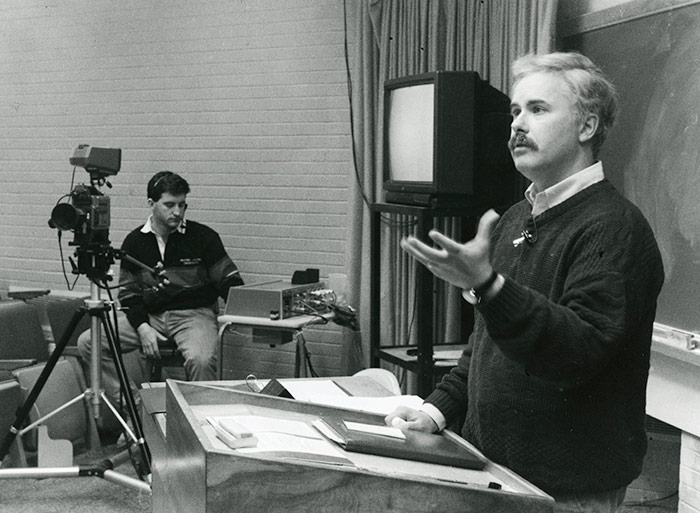
Professor lecturing to an ITV class, ca. 1985. Library Special Collections fonds.
The Years to Come
Looking ahead, Carleton is poised to continue to make a significant impact in Canada and around the world, with thousands of students graduating each year who are making important contributions. On campus, Carleton is expanding with its buildings for Health Sciences and Advanced Research and Innovation in Smart Environments (ARISE), allowing more space for innovative research and education. Further developments in academic programming at Carleton continues to respond to the needs of the workforce and our changing world and by our centennial anniversary, there will be many more accomplishments to celebrate.
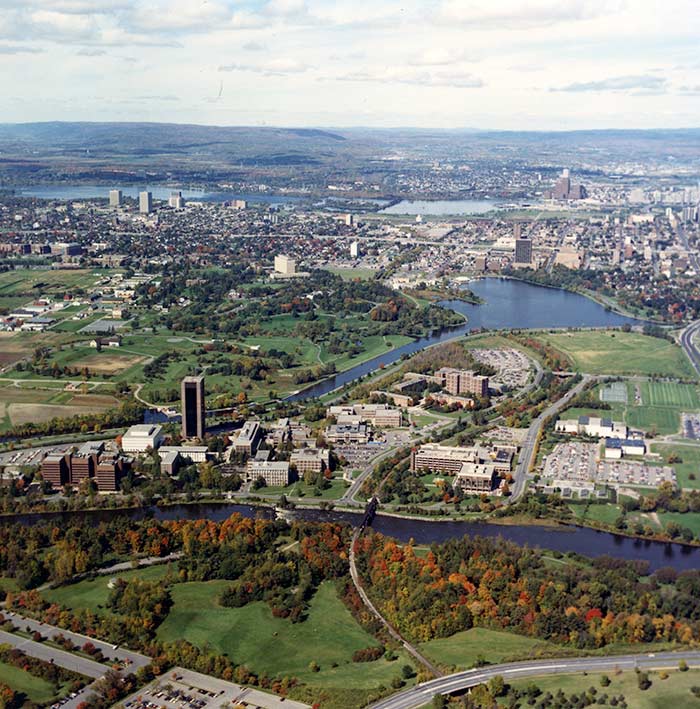
Aerial view of Carleton University, c. 1988. Library Special Collections fonds.
Content: Archives and Research Collections, Carleton University Library and Carleton University Corporate Archives. A Young Canada Works in Heritage Organizations project.